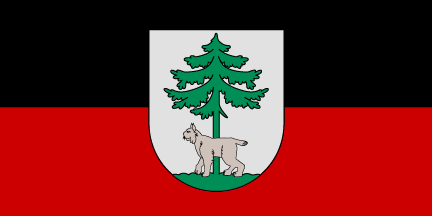
by Gvido petersons, 25 July 2000

Last modified: 2014-05-29 by zoltán horváth
Keywords: jekabplis | courland | krustpils | kreutzburg | latgale | livland | sloboda | daugava | sala pub | jacobstadt |
Links: FOTW homepage |
search |
disclaimer and copyright |
write us |
mirrors

by Gvido petersons, 25 July 2000
See also:
Recently a flag for Jekabpils city was introduced . The design
of flag is close to flag of Kuldiga
and have common roots - heraldic colors of Duke Jacob of Courland.
Population: 28 384 (1999). Area: 23 sq.km.. Distance to Riga: 145
km.
From Jekabpils city map (Jana seta Map Publishers 1999):
"The present borders of the city were set in 1962 when the
neighbouring city Krustpils was joined to Jekabpils. The history
of Krustpils goes back to 1237 - as it has been mentioned in
historical chronicles, this is the year when Nicholas de
Magdeburg built Krustpils (Kreutzburg) Castle. This was the first
castle built by the German invaders in Latgale (Livland).
Gradually a small village spread around the castle building. In
1585 the Polish King Stefan batory presented Krustpils to
Nicholas Korf. The Korfs left their estates as late as in 1920.
The only descendants of the Korfs still keeps in touch with the
present hosts in the castle. In 1626 severe battles took place
between Swedish and Polish troops around Krustpils Castle. The
Poles won the battle, however it took two centuries for the
people of Krustpils to restore the damage caused.
Jekabpils was formed in the middle of the 17th century as a
settlement (the so-called Sloboda) of the persecuted Old
Believers from Russia near Sala Pub on the left bank of the
Daugava. Its upswing was fostered by the passing-by trackers, who
due to the riffles of the river had to trans-ship their goods
into carts. The Daugava lost its strategic significance in 1861
when the railway Riga-Daugavpils was built. In 1670 the
settlement aroun Sala Pub received city rights and was named
after its founder, the Duke of Courland as Jekabpils
(Jakobstadt)".
Gvido Pētersons, 25 July 2000